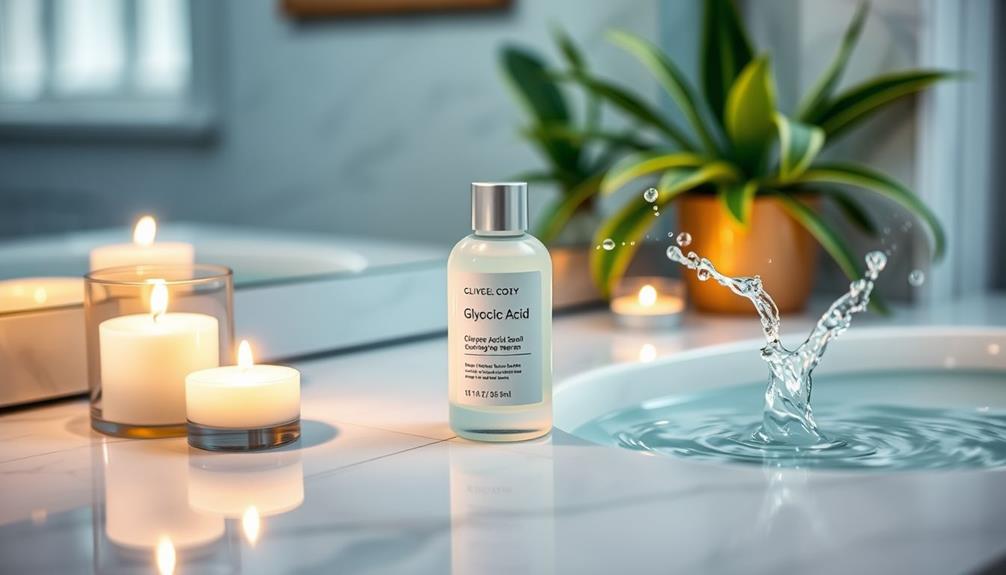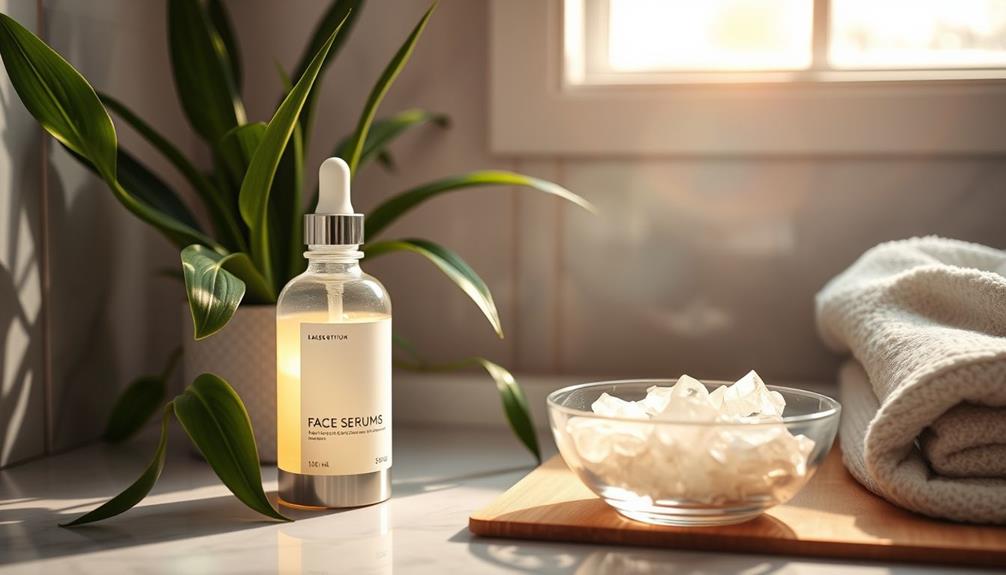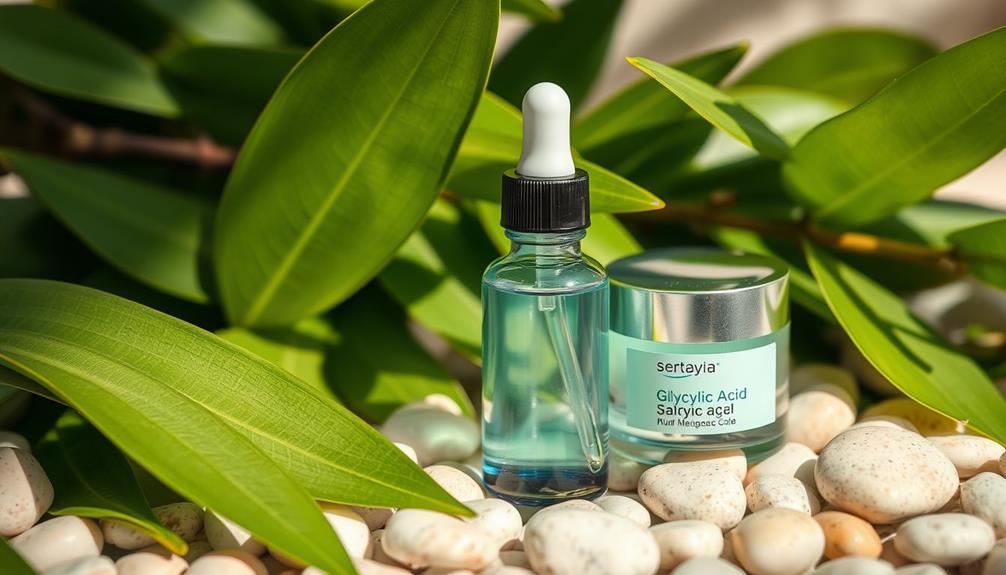Dermatologists in the United States recommend glycolic acid for its powerful exfoliating benefits, which helps to improve skin texture and brightness. By gently removing dead skin cells, it promotes a smoother and more radiant complexion. It is suggested to start with a lower concentration of 5-10% to test your skin’s tolerance. Regular use of glycolic acid can assist in reducing acne, fading dark spots, and enhancing overall clarity. Brands such as The Ordinary or L’Oréal offer effective options to consider. It is important to always use sunscreen when using glycolic acid during the day. If you are interested in learning more about how to incorporate it into your skincare routine or which products work well together, there is additional useful information to explore.
Key Takeaways
- Dermatologists recommend starting with a glycolic acid concentration of 5-10% to assess skin tolerance and minimize irritation.
- Use glycolic acid primarily at night and always follow with sunscreen during the day to protect skin from sun sensitivity.
- Gradually increase usage frequency based on individual skin tolerance to achieve optimal exfoliation without causing excessive dryness or irritation.
- Combine glycolic acid with hydrating ingredients like hyaluronic acid to enhance moisture retention while exfoliating the skin.
Overview of Glycolic Acid
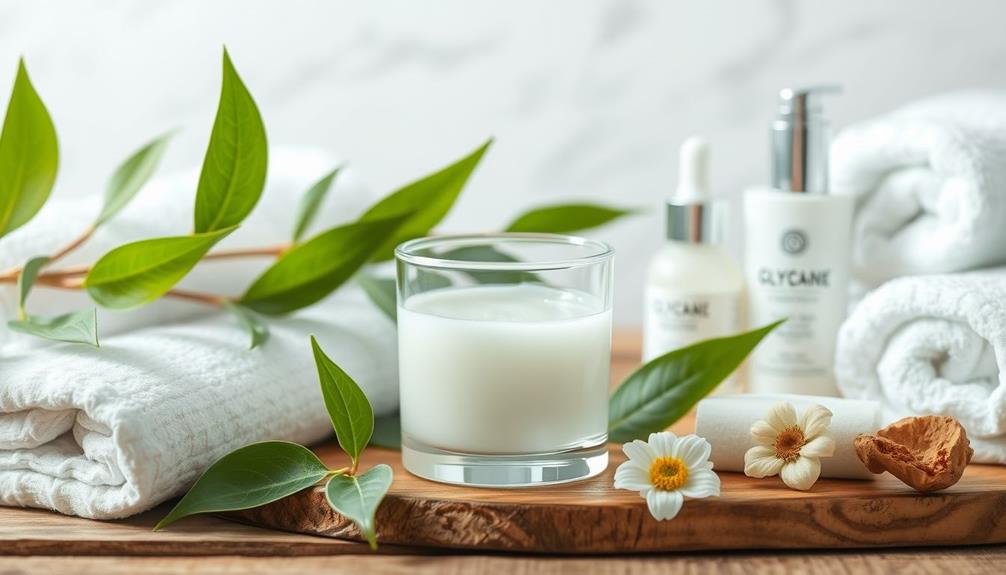
Glycolic acid, the smallest alpha-hydroxy acid derived from sugarcane, is a powerful exfoliant that effectively enhances your skin's texture and brightness. This potent ingredient works by dissolving the bonds between dead skin cells on your skin's surface, allowing for improved cellular turnover. As a result, you'll notice a smoother and more radiant complexion.
Additionally, incorporating aromatherapy techniques such as inhalation or topical application of essential oils can complement your skincare routine and promote relaxation.
In addition to enhancing skin texture, glycolic acid boosts collagen production, which supports increased skin elasticity and helps minimize fine lines and wrinkles. If you're struggling with acne, hyperpigmentation, or uneven skin tone, this exfoliant can be particularly beneficial. It unclogs pores and targets skin concerns that can affect your confidence.
Dermatologists recommend starting with lower concentrations of glycolic acid, typically around 5-10%, to gauge your skin's tolerance. As your skin acclimates, you can gradually increase the frequency of use for peak results.
Key Benefits of Glycolic Acid

Glycolic acid offers several key benefits for your skin that can transform your complexion.
It not only exfoliates and promotes skin renewal but also helps treat and prevent acne while brightening your skin tone.
Additionally, incorporating natural alternatives such as essential oils for skin can further enhance your skincare routine.
Exfoliation and Skin Renewal
Exfoliating with glycolic acid reveals a smoother, more radiant complexion by effectively removing dead skin cells and promoting cell renewal. As the smallest alpha-hydroxy acid (AHA), glycolic acid penetrates deeply, enhancing cellular turnover and allowing fresher skin to emerge.
Regular use can greatly improve your skin's brightness and clarity by dissolving the bonds between dead skin cells. Additionally, incorporating somatic therapy techniques, such as self-exploration through body awareness, can complement your skincare routine by fostering a holistic approach to self-care and emotional well-being.
Incorporating glycolic acid into your skincare routine not only provides immediate exfoliation benefits but also stimulates collagen production. This helps improve skin elasticity and reduces the appearance of fine lines and wrinkles over time.
Furthermore, clinical studies show that consistent use can greatly reduce hyperpigmentation and dark spots, leading to a more even skin tone.
While glycolic acid is known for its exfoliating properties, it also prepares your skin for further treatments, enhancing their effectiveness. By clearing clogged pores, glycolic acid can contribute to better acne treatment outcomes and help prevent future breakouts.
Acne Treatment and Prevention
Using glycolic acid can considerably enhance your acne treatment routine by effectively unclogging pores and preventing breakouts. This powerful ingredient works by exfoliating dead skin cells, promoting cell turnover, and regulating sebum production, which is essential for managing oily skin. Regular use can lead to fewer blemishes and a reduction in post-acne hyperpigmentation.
To help you understand the key benefits of glycolic acid for acne treatment, here's a quick overview:
| Benefit | Description |
|---|---|
| Unclogging Pores | Effectively removes impurities and prevents future breakouts. |
| Exfoliating Dead Skin Cells | Helps reveal fresh skin underneath, reducing acne visibility. |
| Regulating Sebum Production | Controls oiliness, decreasing the likelihood of acne formation. |
Dermatologists recommend starting with lower concentrations of glycolic acid, typically around 5-10%. This approach allows you to gauge your skin's tolerance before increasing frequency or strength. By incorporating glycolic acid into your routine, you can achieve clearer, healthier skin while effectively addressing acne concerns.
Brightening and Even Skin Tone
Achieving a brighter, more even skin tone is possible with the regular use of glycolic acid, thanks to its powerful exfoliating properties that promote cell turnover. This effective ingredient exfoliates the outer layer of your skin, helping to reduce dullness while enhancing overall brightness.
By regularly incorporating glycolic acid into your skincare routine, you can minimize hyperpigmentation and dark spots, leading to a more uniform complexion. Additionally, practicing mindfulness and self-care routines, such as gentle yoga stretches, can further enhance your overall skin health and well-being.
Studies show that consistent use can lighten your skin tone by one to two shades when combined with other AHAs. Glycolic acid's small molecular size allows it to penetrate deeply, stimulating collagen production, which is essential for improving skin elasticity and firmness. As a result, you'll notice not only a brighter appearance but also a smoother skin texture.
Furthermore, dermatologists often recommend glycolic acid for refining enlarged pores, giving you a polished look. Whether you opt for glycolic acid serums, toners, or masks, these skincare products can be beneficial in your quest for an even skin tone. Embrace glycolic acid, and you'll be on your way to radiant, revitalized skin.
Recommended Glycolic Acid Products
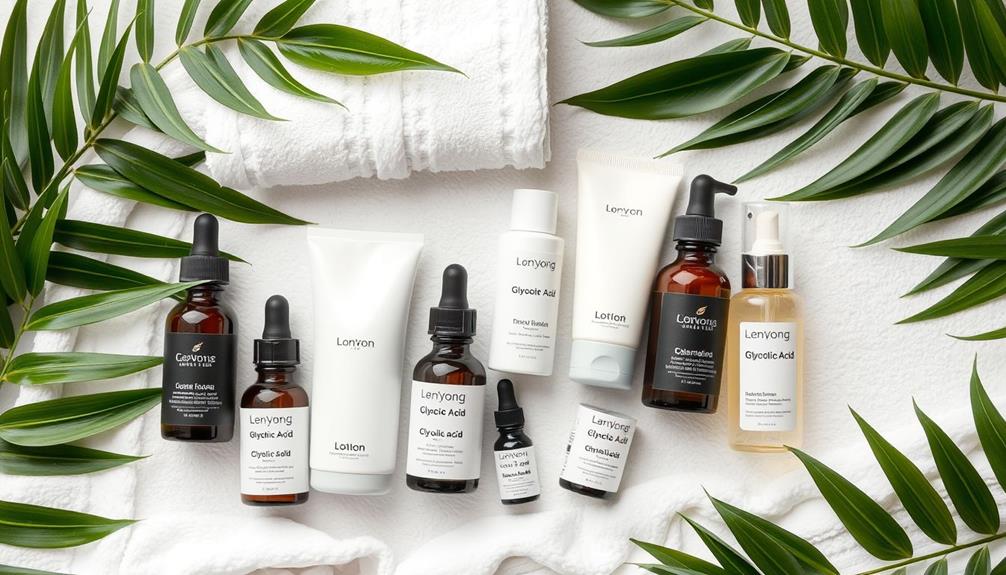
When choosing glycolic acid products, you'll find options that cater to every budget and skin concern.
It's crucial to evaluate your skin type and any sensitivities you may have, as proper product selection can enhance your skincare routine.
From affordable toning solutions to professional-grade peels, there's something for everyone.
For instance, understanding the importance of cat health and nutrition can parallel the necessity of selecting the right ingredients for your skin.
Let's explore the best choices for achieving your skincare goals.
Best Budget-Friendly Options
Finding budget-friendly glycolic acid products can considerably enhance your skincare routine without breaking the bank. One standout option is The Ordinary Glycolic Acid 7% Toning Solution, priced at just $10. It provides effective exfoliation, helping to improve texture and clear pores while keeping your budget intact. Regular use of glycolic acid can also boost skin hydration, making it a versatile addition to your regimen.
If you're looking for a serum, consider the L'Oréal Revitalift 10% Pure Glycolic Acid Serum for around $33. This product not only enhances your complexion but also delivers visible results.
For a gentle cleansing experience, the Sobel Skin Rx 27% Glycolic Acid Facial Cleanser costs about $42 and effectively exfoliates while removing makeup and impurities. It's great for those who want gentle cleansing alongside glycolic benefits.
Moreover, cat health and nutrition can also play a role in your overall well-being, just as skincare does. In addition, Glytone Enhance Brightening Solution offers a reasonable price for its effectiveness. This product combines glycolic acid with other organic acids to hydrate your skin and target dark spots, making it a valuable addition to your budget-friendly skincare routine.
With these options, you can achieve glowing skin while being mindful of your wallet.
Professional-Grade Treatments
For those ready to elevate their skincare routine, professional-grade glycolic acid treatments can deliver impressive results in skin texture and clarity.
One standout is Dr. Dennis Gross Alpha Beta Extra Strength Daily Peel, which combines glycolic acid with other acids for deep exfoliation, making it ideal for oily, normal, and combination skin types.
If you're looking to target dark spots while hydrating your skin, consider the Glytone Enhance Brightening Solution. This dermatologist-recommended product contains glycolic acid and effectively smooths your complexion.
Another excellent option is L'Oréal Revitalift 10% Pure Glycolic Acid Serum, trusted by skincare professionals for its ability to enhance overall skin complexion. Many users report visible results within just weeks of consistent use.
For nighttime application, the Drunk Elephant Glycolic Acid Serum is a dermatologist-approved choice that promotes skin resurfacing and improves texture through glycolic acid and antioxidants.
Incorporating these professional-grade glycolic acid products into your routine can greatly transform your skin, leaving it smoother, brighter, and more youthful.
Don't underestimate the power of these dermatologist-recommended treatments!
Targeted Skin Concerns
Many people struggle with specific skin concerns, and glycolic acid products can effectively target issues like dullness, dark spots, and uneven texture. These dermatologist-approved skin care products work as a chemical exfoliant, helping to exfoliate and brighten the dull and outer layers of your facial skin. Here's a quick overview of some recommended glycolic acid products to improve skin texture:
| Product Name | Concentration of Glycolic Acid | Key Benefits |
|---|---|---|
| The Ordinary Glycolic Acid Solution | 7% | Daily exfoliation, budget-friendly |
| L'Oréal Revitalift 10% Pure Glycolic Acid Serum | 10% | Clears pores, enhances skin tone |
| Drunk Elephant Glycolic Acid Serum | Nighttime use | Smoother texture, reduces dullness |
For more intensive treatments, consider Glytone Enhance Brightening Solution for dark spots or Sobel Skin Rx 30% Glycolic Acid Peel Concentrate for deeper exfoliation. These products harness the power of glycolic acid to address targeted skin concerns effectively, leading to clearer, more radiant skin.
Usage Guidelines for Glycolic Acid

To effectively use glycolic acid, start with a concentration of 5-10% and apply it once a week, gradually increasing frequency based on how your skin reacts. Everyone's skin types are different, so it's crucial to monitor your skin tolerance.
Here are some usage guidelines to keep in mind:
- Patch Test: Always conduct a patch test before using glycolic acid on your entire face. This helps assess your skin's sensitivity and minimize irritation.
- Night Use: Apply glycolic acid primarily at night. This helps reduce sun sensitivity, and don't forget to use a broad-spectrum sunscreen during the day.
- Timing: After cleansing, wait 20-30 minutes before applying glycolic acid. This allows your skin's pH to normalize for maximum efficacy.
- Follow Up: After application, use a hydrating serum or moisturizer to combat any dryness or irritation caused by the acid.
Combining Glycolic Acid With Other Ingredients
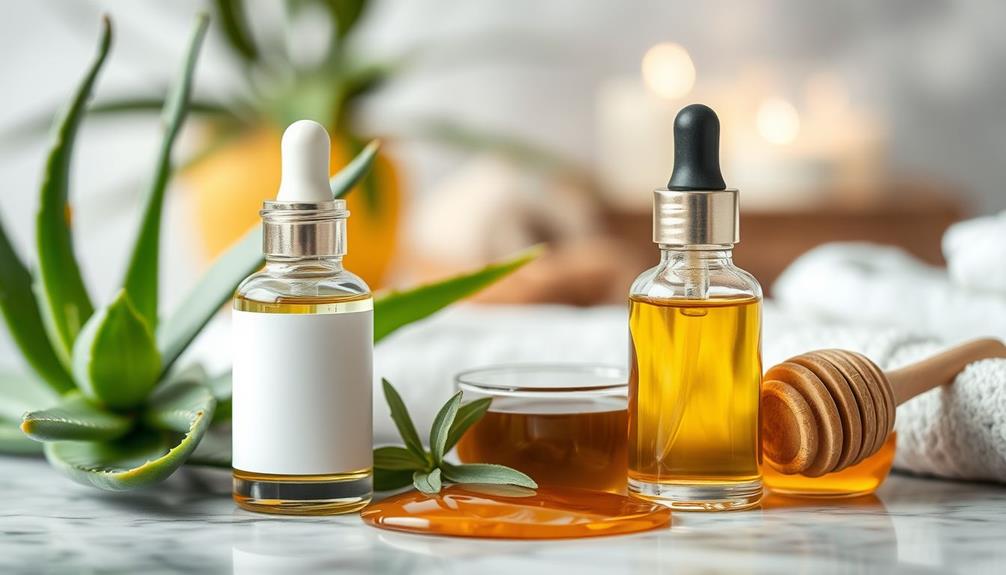
Understanding how glycolic acid interacts with other ingredients is vital for maximizing its benefits while minimizing irritation. Here's a quick overview of which ingredients can work well with glycolic acid and which should be used separately:
| Ingredient | Recommendation |
|---|---|
| Vitamin C | Use in the morning; avoid combining at night to prevent irritation. |
| Niacinamide | Apply at different times; niacinamide in the morning, glycolic acid in the evening. |
| Hyaluronic Acid | Layer together; enhances hydration without compromising exfoliation. |
| Retinoids | Avoid combining; use separately to maintain effectiveness and reduce irritation. |
Incorporating glycolic acid into your skincare routine can lead to significant skin brightening effects, especially when combined with hydroquinone, but consult your dermatologist for personalized advice. It's imperative not to layer glycolic acid with other strong chemical exfoliants, like salicylic acid or additional AHAs, to minimize irritation. Balancing these ingredients effectively can elevate your skincare game while keeping your skin healthy and glowing.
Professional Treatments With Glycolic Acid
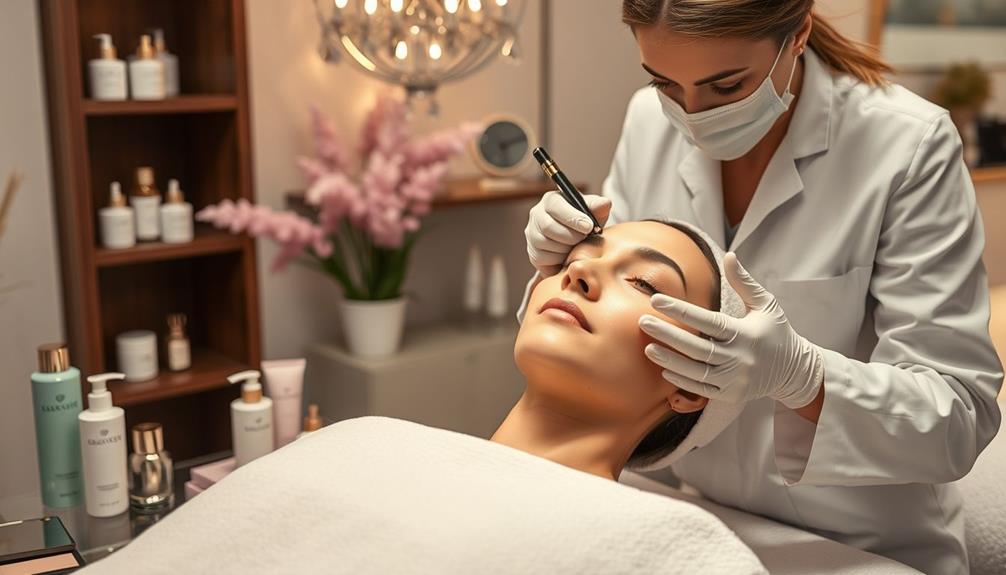
Glycolic acid isn't just a powerful ingredient for at-home use; it's also a key player in professional treatments that can deliver more dramatic results for skin concerns like acne and hyperpigmentation. Dermatologists often recommend professional chemical peels with glycolic acid concentrations ranging from 30% to 70%. These peels provide deeper exfoliation, leading to noticeable improvements in skin texture after just one session.
When considering professional glycolic acid treatments, keep these points in mind:
- Frequency: Treatments are typically suggested every 4 to 6 weeks, depending on your skin type and goals.
- Customization: Many dermatology clinics offer customized treatments, adjusting the peel strength based on your specific concerns and skin sensitivity.
- Post-Treatment Care: After your peel, dermatologists emphasize the importance of using gentle cleansers and moisturizers to support healing.
- Sun Protection: Sunscreen is essential post-treatment to protect your skin and maintain results.
Considerations for Different Skin Types
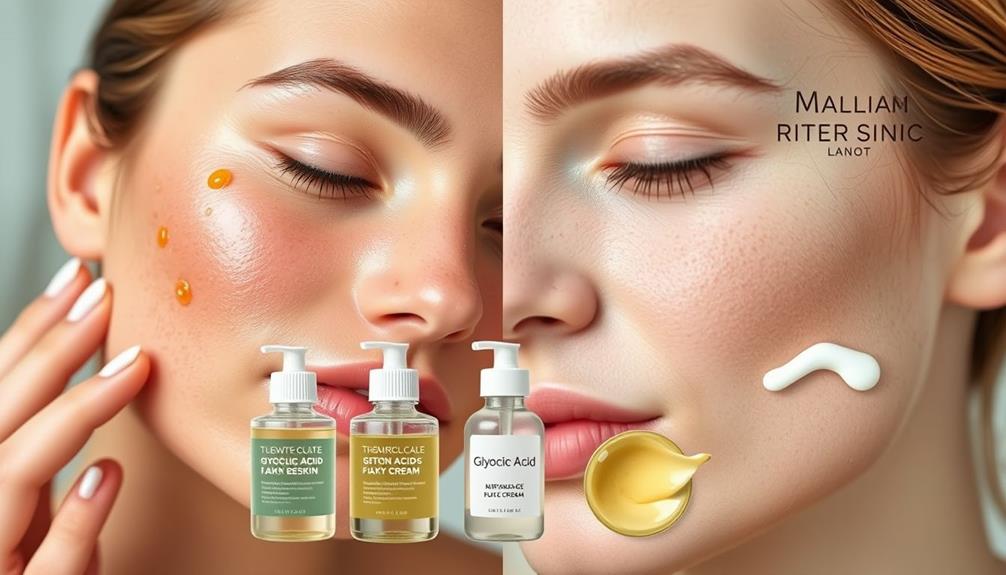
Choosing the right glycolic acid concentration for your skin type can make all the difference in achieving healthy, glowing skin.
For oily skin, glycolic acid works wonders by controlling sebum production and unclogging pores, which helps reduce acne and breakouts.
If you have dry skin, start with a lower concentration of around 5-8% to avoid irritations while still effectively exfoliating dead skin cells and maintaining hydration.
If you're dealing with sensitive skin, it's best to introduce glycolic acid gradually. Begin with a wash or toner that contains low concentrations to assess your skin's tolerance.
For combination skin, consider alternating glycolic acid products with hydrating ingredients; apply glycolic acid to oilier areas while using gentler formulations on drier spots.
Lastly, if you're concerned about aging skin, glycolic acid can help improve skin texture and promote collagen production, reducing the appearance of fine lines and wrinkles.
Frequently Asked Questions
Do Dermatologists Recommend Glycolic Acid?
Yes, dermatologists recommend glycolic acid for its exfoliating benefits. It helps improve your skin's texture and brightness. They suggest starting with lower concentrations to gauge your skin's tolerance before increasing frequency of use.
What Form of Glycolic Acid Is Best?
Think of glycolic acid as a gentle breeze for your skin. For home use, products with 5% to 10% concentration work best, balancing effective exfoliation with minimal irritation, especially for sensitive skin types.
Which Percentage of Glycolic Acid Is Best?
For best results, start with a 5% glycolic acid product if you're new or have sensitive skin. Gradually increase to 10% as your skin adjusts, ensuring you achieve effective exfoliation without irritation.
Is Glycolic Acid Good for Aging Skin?
Wondering if glycolic acid's your skin's savior? It is! It boosts collagen, enhances elasticity, and reduces fine lines, revealing a smoother, more youthful complexion. Regular use can transform your skin, combating aging with remarkable results.
Conclusion
Incorporating glycolic acid into your skincare routine can transform your complexion, as studies show it improves skin texture in up to 70% of users after consistent use.
Dermatologists recommend starting slowly to see how your skin reacts.
With the right products and proper usage, you can enjoy its benefits while minimizing irritation.
Remember, combining glycolic acid with other ingredients can enhance its effects, but always prioritize your skin type for the best results.

